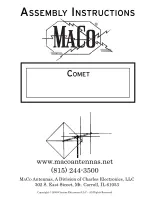
•
If applicable
, check that drain holes in bottom of enclosure and pedestal are not obstructed, and there is
no evidence of water accumulation. Check enclosure doors for proper closure. Verify door seals are intact,
free of tears, abrasions, and/or other damage. Check that all other seals are intact, and repair with coating
of RTV-108 silicone rubber sealant as needed to seal any exposed electrical fittings, bolt holes, and/or
other points of possible water entry to electrical components in order to maintain a waterproof condition. If
enclosure has a vent fan, inspect fan blade for freedom of operation. Fan bearings are permanently
lubricated. However, any binding, abnormal noises, and/or vibration means
replacement of the fan
assembly is needed
. Check fan filter element and, if dirty or obstructed with dust, replace it.
•
Visually inspect all mechanical parts for freedom of operation with no misalignment, binding, or
interference. Check all cabling for sufficient slack in order to prevent cable strain while still providing
enough restraint to adequately prevent abrasions and/or chaffing during antenna and feed movement
•
Check antenna mounting and interconnecting assembly hardware for security. Verify that all electrical
grounding connections (including cross-axis grounding straps) are intact and secure, free of corrosion or
breaks. Use a wire brush to thoroughly clean any noticeably corroded portions of grounding cables, the
un-plated portion of universal terminals, and corresponding mounting surfaces. ANY LOOSE A-325
HARDWARE MUST BE REPLACED RATHER THAN TIGHTENED. A-325 hardware distorts at initial
installation and, once loosened, will not maintain the required high strength friction connection. All other
(not A-325) assembly and installation hardware should be tightened to its original torqued condition.
When installing new structural hardware, do not use a wrench with a lever arm longer than two (2) feet
•
Examine all painted aluminum or galvanized surfaces for chips, cracks, or deep gouges, and touch-up
spots as needed
-
-
-
-
-
-
-
-
-
-
-
-
-
-
4.2.3 Drive System Voltage & Current Checks
At the conclusion of the installation procedure prior to turning the system over to the station facility, an
installation acceptance check off sheet was prepared and duly signed off if installed by
Kratos
crew. Part
of this check off included voltage readings retaken to determine if proper voltage was available. Current
readings were also taken as a reference for future comparison to serve as a troubleshooting aid in
determining possible equipment degradation and shortened life. Any current reading taken during the
following procedure that varies by more than five percent from the pre-established reference values
necessitates troubleshooting the particular system involved to determine the cause and required
corrective action.
Approximately every three months and during a period of down time, disconnect as applicable the RF
transmitter and all power supplies. The main disconnect switch in the main load center box at the antenna
site must be in the ON position and the LOCAL/REMOTE switch in the local control motor drive controller
must be in the LOCAL position.
•
Open the outer local control/motor drive controller door at the antenna site to gain access to the
conductors supplying power to the azimuth, elevation, and polarization drive motors.
NOTE:
During the following procedures, the antenna drives (Az, El, and Pol) will be powered to rotate antenna and feed in
both directions of travel. Check that this condition can be tolerated from a safe and operational standpoint, and that the
electrical limits are not reached before testing is concluded. Reaching an electrical limit before concluding a test
necessitates rotating antenna or feed in opposite direction to a sufficient distance to permit retesting in desired direction.
•
Turn the FEED CCW/OFF/CW switch to either the CW or CCW position and while the feed is rotating,
carefully use a clamp on ammeter in accordance with the ammeter manufacturer’s instructions to take
current readings off each of the three conductors (phases) connected to the load side of the
polarization motor circuit breaker. Record the current draw in the equipment log and compare the
readings to the reference values entered in the installation/acceptance check off. If the readings differ
by more than five percent, refer to appropriate troubleshooting information and perform applicable
corrective action. Then take voltage readings off each of the three conductors; the readings should
agree with each other within two percent. Turn the FEED CCW/OFF/CW switch to OFF.
•
Repeat preceding step with the FEED CCW/OFF/CW switch in the alternate operating position.
•
Turn the AZIMUTH EAST/WEST switch to either position and while the antenna is rotating, carefully
OM45T_
Rev N
Page 20









































